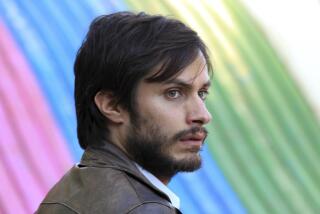Freedom’s beat
- Share via
THE Statue of Liberty and the Twin Towers figure prominently in Tom McCarthy’s “The Visitor,” an unassuming but quietly heartbreaking drama about the unexpected bonds that can form in a city like New York, and their depth and fragility in times of hysteria. These monuments have become bookends to an era, yet McCarthy, an actor-turned-director who previously directed “The Station Agent,” treats the symbols lightly, concentrating instead on the interplay between his unlikely quartet of characters.
“The Visitor” stars the wonderful Richard Jenkins as Walter Vale, a widowed economics professor in Connecticut. Vale lives alone in a suburban house as white and desolate as a snowdrift, trying to learn the piano as a way to remain connected to his deceased concert pianist wife. He’s been sleepwalking through his job for years, teaching the minimum number of courses and stalling on his next book, when he’s unexpectedly asked to stand in for a colleague and present a paper he co-authored at a conference in New York.
On arriving at his apartment in the city, Walter notices signs of life -- the most impossible to ignore being a terrified Senegalese woman in his bathtub. Zainab (Danai Gurira) is living at Walter’s place with her Syrian boyfriend, Tarek (Haaz Sleiman), who was scammed into the living arrangement by a con artist. Young, poor and illegal, the young couple worry that Walter will call the police. Instead, he unexpectedly offers them a place to stay the night.
It’s tempting to describe McCarthy’s movie as a story about the effect of draconian post-Sept. 11 immigration laws on individuals, but this would make it sound like the kind of issue-driven movie that plays like a scolding and feels like a chore. “The Visitor” is far from that. It’s a film about relationships, their randomness and unpredictability, and what happens when bureaucracy attempts to make life conform to its rigid, parochial and often ignorant standards.
Tarek is a musician and an open, trusting soul (and a radiant Sleiman portrays him with uncommon warmth, openness and humanity). Grateful, Tarek takes an immediate liking to Walter (unlike the wary Zainab, who unconsciously recoils in his presence), easily engaging him in a way no one has been able to do throughout the film. Tarek’s wide-openness is a striking contrast to Walter’s introverted alienation, and watching this awkward, lonely man come to life again is strange and touching.
Tarek introduces Walter to the djembe, a West African drum that’s played with bare hands, and soon Walter is rushing through his conference so he can get back to hanging out with Tarek, practicing the drum, attending gigs and hanging out with other drummers in the park. One afternoon, while the two friends are hurrying back to the apartment to meet Zainab, Tarek is arrested because of a misunderstanding and transferred to a detention center. As Walter becomes increasingly involved in Tarek’s predicament, a scared and traumatized Zainab drifts ever further away.
After she doesn’t hear from her son in a few days, Tarek’s mother shows up at Walter’s door. Mouna (Hiam Abbass) lives in Michigan, where she and Tarek landed after the death of Tarek’s father, a journalist jailed for seven years in Syria for something he wrote. Mouna and Tarek were denied asylum, which is why Tarek now finds himself in the predicament he’s in. Over the next several weeks, Mouna and Walter make a connection that transcends nationality and circumstance, forming a bond that neither has felt in a long time.
In one scene, Mouna asks Zainab to take her somewhere she and Tarek liked to go together, and Zainab takes her and Walter on the ferry to Staten Island. She points out where the Twin Towers used to be -- “I never saw them, but Tarek did,” she tells them, then points out the Statue of Liberty and Ellis Island, which Tarek used to jokingly pretend he was seeing for the first time and jump up and down with excitement like a child. In another scene, the World Trade Center and the Statue of Liberty can be seen standing side by side on a mural on the wall at the detention center where Tarek is being held. Their compression into one image gives off a slightly menacing tone, especially given the context. The mural seems to represent the fulcrum on which “liberty” became post-Sept. 11 “freedom,” as in the stuff our military spreads by force. It hovers over the detention center waiting room -- a vale of frustration and despair if there ever was one -- in sharp contrast to the awe-inspiring statue.
What “The Visitor” makes clear is how Tarek’s incarceration is senseless and tragic, not only because of what it means for him, but for how far and wide the effects of what happens to him reverberate, and how dehumanizing and ultimately de-civilizing such policies can be.
--
--
“The Visitor.” MPAA rating PG-13 for brief, strong language. Running Time: 1 hour, 43 minutes. Exclusively at ArcLight in Hollywood and Landmark in West L.A.
More to Read
Sign up for our Book Club newsletter
Get the latest news, events and more from the Los Angeles Times Book Club, and help us get L.A. reading and talking.
You may occasionally receive promotional content from the Los Angeles Times.










